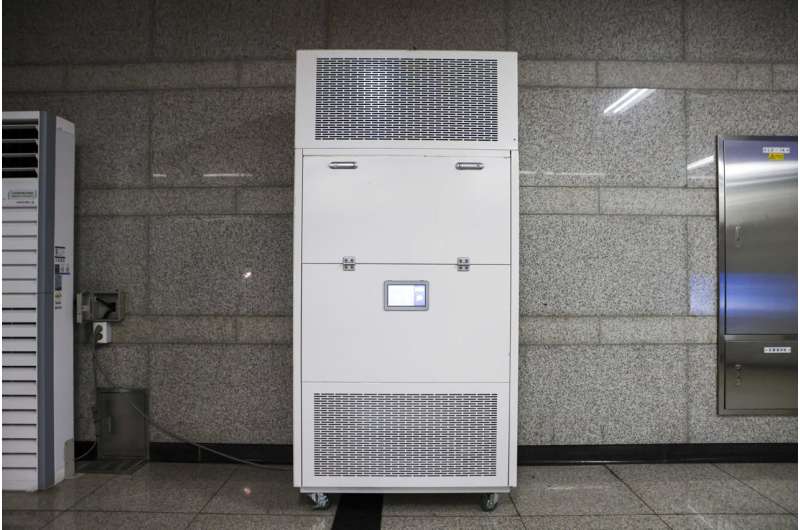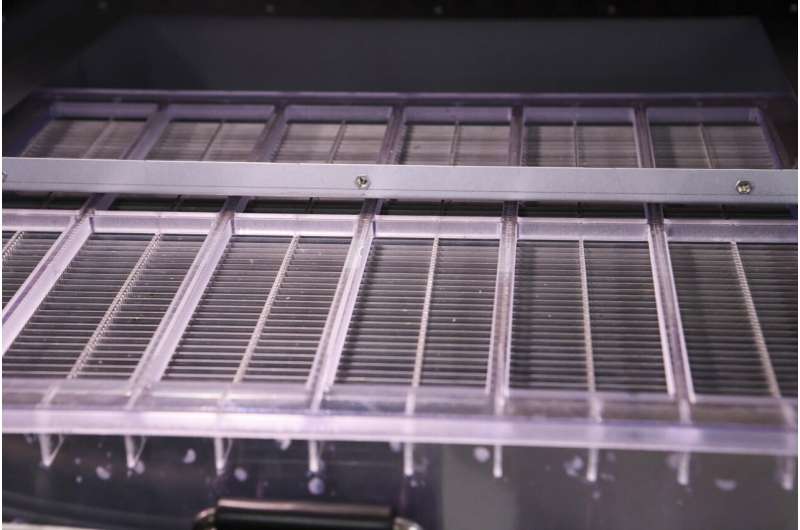This article has been reviewed according to Science X's editorial process and policies. Editors have highlighted the following attributes while ensuring the content's credibility:
fact-checked
proofread
Filter-free, electrostatic technology for ultrafine particle reduction

A technology that uses an electrostatic method to reduce ultrafine particles without a filter was developed for the first time in the world.
The Korea Institute of Machinery and Materials (KIMM), an institute under the jurisdiction of the Ministry of Science and ICT, has succeeded in the development of a filter-free air purifying technology to collect ultrafine particles using soft discharge and electrostatic precipitation, and clean collection plates by air spray and vacuum suction. KIMM initiated a full-scale demonstration study in subway stations such as waiting rooms, platforms, and tunnels which are extremely large indoor spaces.
Principal Researcher Kim Hak Joon and his research team in the Department of Sustainable Environment Research at KIMM's Eco-Friendly Energy Conversion Research Division have developed a novel electrostatic precipitator with zero-ozone emission, low back-pressure and high clean air delivery rate. This technology uses microfiber discharge electrodes and non-metallic conductive plates to remove ultrafine particles within a very short time in a large subway station.
When a soft discharge which consumes very low current at the micro electrode tips is generated, sufficient unipolar ions are generated without ozone generation and attached onto airborne ultrafine particles, and also the ions are sprayed in the subway station to charge more airborne particles in the station.
Any ultrafine particles that get charged by these ions are flowed into air handling units and air purifiers by their suction fans, and are collected in electrostatic precipitation units by electrostatic force. As the collected particles are accumulated on collection plates so the purification capacity of the removal device decreases, a strong airflow is generated in front of the particle collection unit to separate the contaminated dust from the unit. At the same time, a vacuum cleaner sucks in the detached dust from the back and keep the unit clean without using water spray which is a typical cleaning method for electrostatic precipitators.
The KIMM research team is currently conducting a full-scale demonstration experiment by installing air handling units and air purifiers equipped with this novel technology in the Yuseong Spa subway station in Daejeon, Korea. The results that have been obtained so far show that this technology can reduce the concentration of ultrafine particle in the inflowing air by up to 90%.
With the filter-type air purifying technology that has been commonly used up until now, when dust accumulates on the filter, it blocks airflow through air handling units and air purifiers resulting in a large pressure loss and consequently in a large amount of power consumption. In addition, the filters must be frequently replaced, resulting in replacement costs of at least billions of Korean won per year.

Typical air purifiers using the electrostatic precipitation method generate a lot of ozone by hard discharge which consumes a lot of currents at electrodes while creating ions, and the particle collectors must be washed with water during cleaning. Because of this cleaning method, there are several disadvantages, such as requiring at least one day to dry the collectors perfectly before applying high voltage to them, the possibility of freezing of water pipe in winter season, and the generation of a lot of wastewater.
Upon applying the newly developed technology by KIMM, almost no ozone is generated when the ions are created. Furthermore, by using air instead of water to clean the dust collector, there is no possibility of secondary pollution. This cleaning method also reduce power consumption by 80%, making it much more economical than conventional electrostatic methods.
KIMM's new technology has been transferred to companies specializing in air cleaning technology, and commercialization is being pursued. In particular, On April 11, a PM2.5 Zero Living Lab will be installed at Daejeon Station Subway Station, where subway users can experience the novel technology and get useful information about how the air quality in subway stations is managed.
The principal researcher, Kim Hak Joon, of the Korea Institute of Machinery and Materials stated that this novel filter-free electrostatic precipitation technology is the only one that can quickly supply a large amount of clean air to a large indoor space like subway stations. He also added that the KIMM research team will continue to work toward solving the environmental problems in multi-use facilities such as buildings and schools caused by ultrafine particulate matters using world-first electrostatic technologies.
















